Origin of Visible Light Photocatalytic Activity of Ag3AsO4 from First-Principles Calculation
Abstract
Recently a novel sliver oxide Ag3AsO4 has been found to be an excellent photocatalyst with strong oxidation capability for pollutant degradation under visible light. But the origin of its high visible light photocatalytic activity was unclear which hindered further research of Ag3AsO4. For clarifying that, the electronic structure and optical properties of Ag3AsO4 have been analyzed by the hybrid density functional method. The results reveal that the Ag3AsO4 presents a narrow band gap with strong oxidation ability of the valence bands maximum edge and the highly delocalized charge distribution of the conduction bands minimum is beneficial for the carriers transfer to surface to participate in the photocatalytic reaction. These results provide clear explanations of the excellent visible light photocatalytic performance of the Ag3AsO4 from microscopic aspect. And it is significant to design novel materials with high photocatalytic performance.
1. Introduction
Semiconductor photocatalysts are finding increasing applications in high-efficiency solar cells [1], water/air purification [2], and water splitting [3, 4]. For the purpose of effectively utilizing solar energy, ideal semiconductor photocatalysts should at least have the two characteristics. One important aspect is a narrow band gap for utilizing the visible light which dominates 43% of the solar light and almost 100% of indoor light. The other one is a suitable band edge position for water splitting and environment pollutants decomposition or other target reactions. In the past decades, overwhelming attention has focused on designing visible-light response photocatalysts, such as BiVO4 [5], CdS [6], and WO3 [7]. However, their low visible-light photocatalytic activity is of course a great inhibition to use as a highly efficient photocatalysts.
Since Yi’s group has reported the strong oxidation power of Ag3PO4 under visible light [8], a series of sliver based oxides has aroused wide attention on account of their excellent photocatalytic abilities under visible light region, such as Ag3VO4 [9], AgSbO3 [10], and Ag2O [11]. Among them, as a novel sliver oxide photocatalyst, Ag3AsO4, has been found to be an excellent photocatalyst with powerful oxidation ability under visible light by Tang’s group recently [12]. It has a band gap of 1.6 eV which can fulfill the high absorption capacity of visible light. And the potential of valence band edge is about 2.22 eV that the photogenerated holes own strong oxidation to decompose the pollutants efficiently. Despite important insight being achieved, the mechanisms involved in photocatalysis are not yet clear. Fulfilling this goal requires the assistance of theoretical investigations such as electronic structure calculations. Therefore, a systemic investigation about microscopic mechanism of photocatalysis is vitally important for understanding the excellent photocatalytic performance of Ag3AsO4.
To understand the superior photocatalytic activity of Ag3AsO4 from its intrinsic properties, the first-principles calculations on its electronic structure and optical properties were carried out in our work. As a common problem, the band gaps of the semiconductors are usually underestimated by the conventional DFT methods due to the self-interaction error as well as the missing discontinuity in the exchange-correlation potential. For instance, the band gap error exceeds 2 eV for ZnO [13, 14] and Ag3PO4 [15]. This is adverse to analysis of the redox ability of the semiconductor. The hybrid-DFT with PBE0 formalism has been successfully used as an available method to calculate the band gap accurately, such as Ag3PO4 [16]. So in our work, the hybrid-DFT method PBE0 was applied to calculate the electronic structures and optical properties. The results revealed that the hybrid-DFT method is more precise for the calculation of the electronic and band structures of Ag3AsO4. Furthermore, we analyzed the relations of these microscopic factors to photocatalytic activities of Ag3AsO4.
2. Computational Methods
In this paper, our first-principles calculations were performed using the plane-wave pseudopotential method based on hybrid-DFT with PBE0 formalism, which was implemented in the CASTEP code [17]. Three-dimensional periodic boundary conditions were employed to simulate an infinite solid. The generalized gradient approximation (GGA) in the PBE0 hybrid functional formalism was applied combined with norm-conserving pseudopotentials. To achieve the accurate density of the electronic states, a 4 × 4 × 4 Monkhorst-Pack grid [18] was used for Brillouin-zone sampling. A plane-wave basis set with a cutoff of 400 eV was used. Geometric optimization was achieved and the convergence criterion for the force between atoms was 3 × 10−2 eV/Å, the maximum displacement was 1 × 10−3 Å, and the total energy and the maximal stress were 1 × 10−5 eV/atom and 5 × 10−2 GPa, respectively. The self-consistent convergence accuracy was set at 1.0 × 10−6 eV/atom, and the valence configurations of the pseudopotentials are 4d105s1 for Ag, 4s24p3 for As, and 2s22p4 for O, respectively.
3. Results and Discussion
3.1. Geometry Structure and Bonding Character
The geometry optimization crystal structure of Ag3AsO4 is a cubic structure with P4-3n symmetry which is shown in Figures 1(a) and 1(b). Figure 1(b) presents the polyhedron configurations of the Ag3AsO4. It clearly shows that both the silver and arsenic atoms are coordinated to four oxygen atoms forming AgO4 and AsO4 tetrahedral units, respectively. The optimized cell parameters are a = b = c = 6.22 Å and a = b = c = 90° and agree well with the experimental data of a = b = c = 6.12 Å and a = b = c = 90° [19]. The deviations are less than 1.6% that indicates the accuracy of our calculation. The As–O and Ag–O bond length are calculated to be 1.717 Å and 2.408 Å, respectively. To understand the nature of the chemical bonding behavior, a Mulliken bond population analysis is used. Generally, bond population is a common characteristic used to analyze ionic and covalent characters. When the value of bond population is close to zero, it presents an ideal ionic bond, while higher value demonstrates higher covalent interactions. The result indicates that the As–O bond population is 0.55, and the Ag–O is 0.17. Therefore, the interaction between arsenic and oxygen is achieved mainly by covalent bond, while the interaction between silver and oxygen is formed mainly by ionic bond. Previous study showed that the short Ag–Ag distance results in the formation of the metallic Ag–Ag bond, which contributes to the dispersive conduction bands and a small effective mass of electron [20]. The length of Ag–Ag bond is 3.112 Å which is much smaller than that in Ag2O (3.30 Å) and AgNbO3 (3.90 Å), but a little larger than AgPO3 (2.95 Å). So the shorter Ag–Ag distance in the Ag3AsO4 indicates the metallic Ag–Ag bond which has remarkable influence of the band structure of the Ag3AsO4.
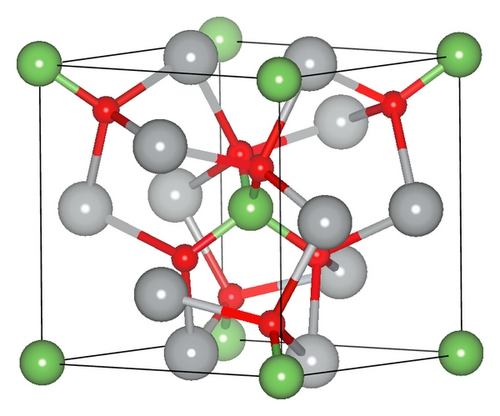
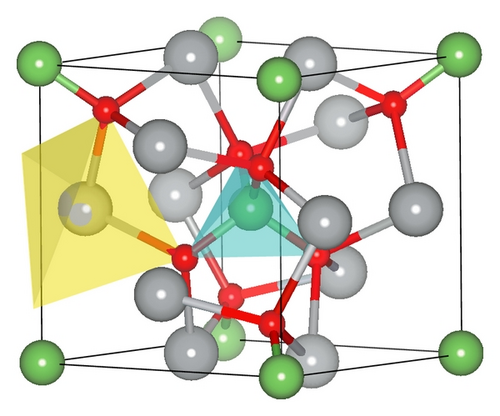
3.2. Band Structures and Density of States
The band structures of Ag3AsO4 determined by PBE0 are shown in Figure 2. The Fermi level (indicated by dashed line) is set as zero. The conduction bands minimum (CBM) is at G point and the valence bands maximum (VBM) is located at M point in the Brillouin zone illustrated in Figure 2. It indicates that Ag3AsO4 is an indirect band gap semiconductor. The indirect gap from M to G is calculated to be 1.67 eV and the direct gap at G is 1.80 eV. The hybrid-DFT method (PBE0) gives a much more credible band gap of 1.67 eV, which agrees well with the experimental value (1.6 eV). From this figure, the bottom of conduction band shows well dispersive, compared with the top of valence band, which manifests that the photogenerated electrons possess smaller effective mass. In general, a lower carrier effective mass corresponds to a higher carrier mobility. So the photogenerated electrons in the conduction band can transfer more rapidly to the surface of Ag3AsO4 to participate in the photocatalytic reaction.
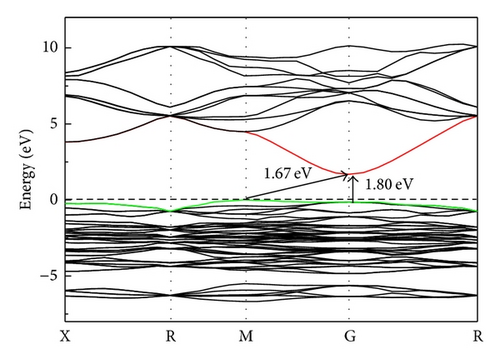
In order to better understand the nature of the electronic band structures, the density of total states (TDOS) of Ag3AsO4 and projected density of states (PDOS) for Ag, As, and O elements calculated by PBE0 are presented in Figure 3. The valence bands are mainly occupied by O 2p and Ag 4d states. Meanwhile, above the Fermi level, the conduction bands are composed of Ag 5s and Ag 5p. As shown in Figure 3, there are no Ag d states in the CBM of the Ag3AsO4. This character is beneficial for the transfer of photogenerated electrons in the CBM, due to the fact that Ag sp states are less localized than Ag d states. Thus the photogenerated electrons in the CBM of Ag3AsO4 can be rapidly transferred to the surface to participate in the reaction. This gives a further detailed explanation of the high photocatalytic performance of the Ag3AsO4.
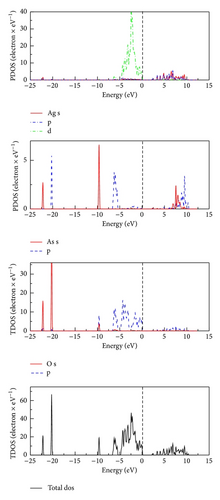
3.3. Redox Potentials
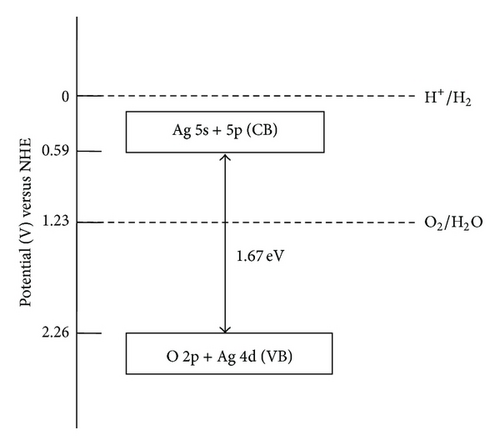
3.4. Optical Absorption
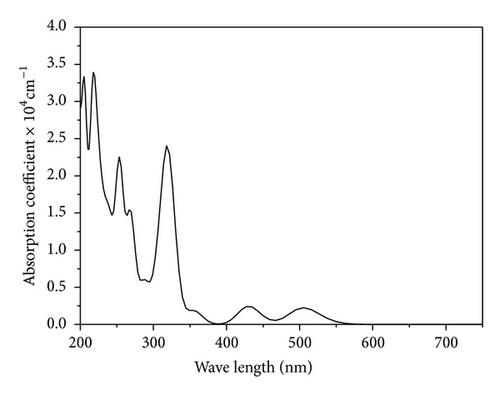
4. Conclusions
In summary, we studied the electronic structure and optical properties of Ag3AsO4 by hybrid density functional method. The origin of the excellent visible light photocatalytic activity of Ag3AsO4 is attributed to the highly dispersive band structure of the CBM resulting from Ag s-Ag p hybridization without localized d states and the narrow band gap with a strong oxidation ability of the VBM edge. The calculation results can raise the level of understanding and provide guidance toward the practical improvement of photocatalytic materials and their applications.
Conflict of Interests
The authors declare that there is no conflict of interests regarding the publication of this paper.
Acknowledgment
This work was supported by the National Natural Science Foundation of China (NSFC-JST 21261140334).




